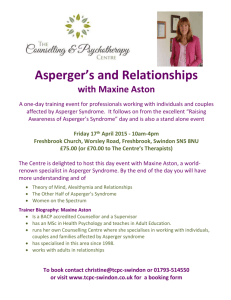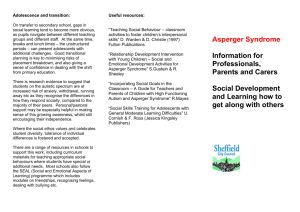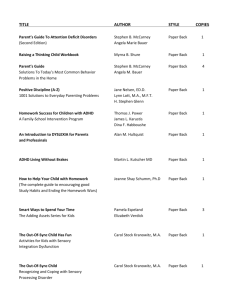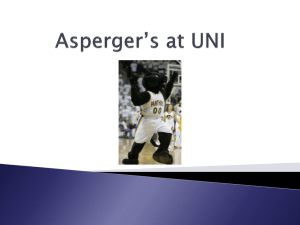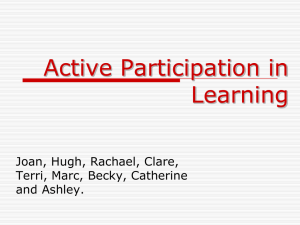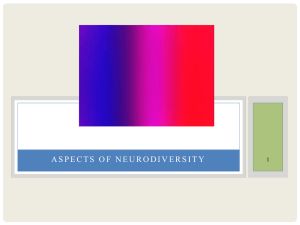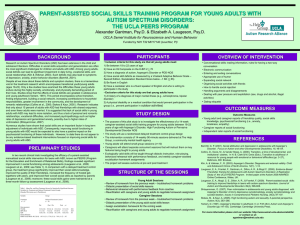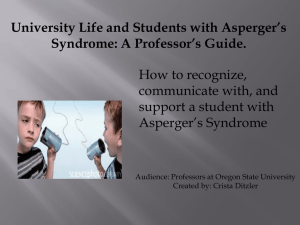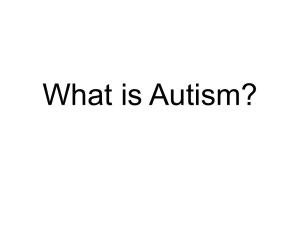Asperger`s Disorder in Secondary Environments
advertisement
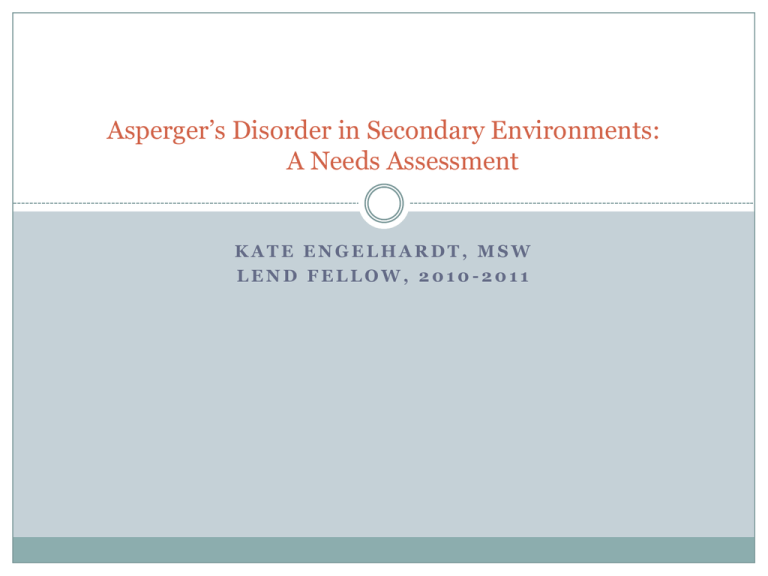
Asperger’s Disorder in Secondary Environments: A Needs Assessment KATE ENGELHARDT, MSW LEND FELLOW, 2010-2011 Background Purpose of the research: Understanding inclusion in secondary school environments Identifying specific areas in need of development amongst secondary school-based professionals Development of personal interest: First internship- school social work in a secondary school Understanding the emotional experiences of students with Asperger’s Disorder in and out of the classroom Varying levels of professional awareness on the impact of exclusion in the school community for identified students and their peers Background The literature says….. General focus is on Classical Autism and Elementary age children (Ballan & Hoban, 2006; Early 1995) Observational studies: Students with disabilities have limited interactions with typically developing peers in classroom scenarios. (Carter et al, 2008) Students with disabilities have few interactions with typically developing peers outside of the classroom (Cutts & Sigafoos, 2001). Students with Asperger’s Disorder may not be identifiable to their peers based on appearance. They can often succeed in general education settings without direct adult assistance (Safran, 2002) Background The literature also says…. In general education settings, students with Asperger’s Disorder can become more identifiable because of their difficulty navigating complex social interactions (Aldoen & Stella, 2001) . Effective communication is essential (Grandin, 2006; Jackson, 2002). Lack of understanding by all members of the school community leads to general frustration, behavioral difficulties, ineffective learning, and high levels of bullying (Biggs, Simpson, & Gaus, 2010; Adreon & Stella, 2001). Group projects in classroom environments can lead to better social learning for all parties. Staff can translate the idea of community effort into the development and modeling of policies that emphasize teamwork and prosocial interactions (Aldoen & Stella, 2001). Research Questions/Hypotheses What training have school based professionals received in relation to inclusion of students with Asperger’s Disorder in secondary schools? Hypothesis: I believe that limited numbers of general education staff will have received Asperger’s Disorder related training while Special Educators and staff members who provide instructional support (social work, guidance counselors, school psychologists, etc) will have some training. What do school based professionals perceive as barriers to creating a fully inclusive secondary school community? Hypothesis: I believe that professionals will identify a lack of resources and training as barriers to creating an inclusive school community Research Questions/Hypotheses Are school based professionals willing to collaborate with professionals from other disciplines when shaping school policy? I believe that professionals will report that they typically work within their own discipline What professions do school based professionals identify are necessary to the collaborative process? I believe that professionals will report that they typically work within their own discipline Methods Participants – All professionals at one Connecticut High School including general education teachers, administrators, instructional support professionals, graduate interns, etc. were included in the study. All responses were anonymous. Recruitment – Initial contact requesting permission occurred with the school social worker and building administrator. Following approval, questionnaires, introductory letters, and addressed, postage paid envelopes were placed in all staff mailboxes. Sample size – N=79 Methods Measures and Instruments Participants were asked to complete a 16 item quantitative questionnaire. Items on the questionnaire targeted: Prior training regarding Asperger’s Disorder Willingness to participate in future training with the option of specifying types of training Staff perception as barriers to referrals and full inclusion Staff experiences with referring students for support services Staff history of interdisciplinary teamwork in developing policy proposals Professional background and demographics Methods Data Collection and Analysis Questionnaires were returned to the A. J. Pappanikou Center via mail. Responses were entered into SPSS for data analysis two weeks after survey distribution. Results: Demographics Response rate = 19% (15 surveys) 43% male, 57% female Ethnicity (open-ended response): 100% white, non-Hispanic Race(open-ended response): 92% white 8% human Profession breakdown: 60% = general education teachers 20% = support professionals 13% = paraprofessionals 6% = special education teachers Results: Referrals to Support Professionals 93% of respondents referred students to support professionals during the last school year Results: Policy Collaboration 87% worked with members of other professions regarding policy change Results: Asperger’s-Specific Training 67% have received training specific to Asperger’s Disorder, 90% of those without any follow-up training or technical assistance Results: Interest in Training 100% were interested in receiving training! Results: Training Specifics 86% are willing to commit 1 hour -3 hours to training….where? Results: Barriers to Inclusion 87% felt that limited training regarding Asperger’s Disorder was a barrier to inclusion 67% indicated a lack of general knowledge about the disorder 53% felt that limited collaborative time between professionals was a barrier 47% identified the attitudes of teachers and staff **Please see next slide for graph** Results: Barriers to Inclusion Graph Discussion Implications: Professionals have identified a need and desire for training opportunities. The time specified would be appropriate for a professional development workshop. Improved training, policies, and teamwork can lead to a more inclusive secondary community for the entire student population. Results are not generalizeable due to the small sample size and low response rates. Initial results do indicate the need for further research with an expanded sample. References Adreon, D., & Stella, J. (2001). Transition to middle and high school: Increasing the success of students with asperger syndrome. Intervention in School and Clinic, 36(5), 266-71. American Psychiatric Association., & American Psychiatric Association. (2000). Diagnostic and statistical manual of mental disorders: DSM-IV-TR. Washington, DC: American Psychiatric Association. Attwood, T. (1998). Asperger’s syndrome: A guide for parents and professionals. United Kingdom: Jessica Kingsley Publishers Ltd. Ballan, M. & Hoban, K. (2006). The school services sourcebook: A guide for school-based professionals. New York: Oxford University Press. Batshaw Clair, E. Church, R., & Batshaw, M. (2007). Special education services. In Batshaw, M. L., Pellegrino, L., & Roizen, N. J. (2007). Children with Disabilities. Baltimore: Paul H. Brookes Pub. Biggs, M., Simpson, C., & Gaus, M. D. (2010). Using a team approach to address bullying of students with asperger's syndrome in activitybased settings. Children & Schools, 32(3), 135-142. More References Carter, E. W., & Hughes, C. (2006). Including high school students with severe disabilities in general education classes: Perspectives of general and special educators, paraprofessionals, and administrators. Research and practice for persons with severe disabilities, 31(2), 174-185. Carter, E. W., Sisco, L. G., Brown, L., Brickham, D., & Al-Khabbaz, Z. A. (2008). Peer interactions and academic engagement of youth with developmental disabilities in inclusive middle and high school classrooms. American Journal on Mental Retardation, 113(6), 479494. Cutts, S. and J. Sigafoos . 2001. Social competence and peer interactions of students with intellectual disability in an inclusive high school. Journal of Intellectual & Developmental Disability, 26:127–141. Early, B. (1995). Decelerating self-stimulating and self-injurious behaviors of a student with autism: Behavioral intervention in the classroom. Social Work in Education, 17(4), 244-255. Grandin, T. (2006). Perspectives on education from a person on the autism spectrum. Educational Horizons, 84(4), 229-234. More References Graetz, J. E., & Spampinato, K. (2008). Asperger's syndrome and the voyage through high school: Not the final frontier. Journal of College Admission, (198), 19-24. Individuals with Disabilities Education Improvement Act of 2004, PL 108-446, 20 U.S.C§§1,400 et seq. Jackel, S. (1996). Asperger's Syndrome--Educational Management Issues. Jackson, L. (2002). Freaks, geeks, and asperger’s syndrome: A user guide to adolescence. London and Philadelphia: Jessica Kingsley Publishers. Macintosh, K. & Dissanyake, C. (2006). Social skills and problem behaviors in school aged children with high-functioning autism and asperger’s disorder. Journal of Autism and Developmental Disorders, 36(8), 1065-1076. Last One! Mu, K. , Siegel, E. B., & Allinder, R. M. (2000). Peer interactions and sociometric status of high school students with moderate or severe disabilities in general education classrooms. Journal of the Association for Persons with Severe Handicaps, 25:142–152. Safran, J. S. (2002). Supporting Students with Asperger's Syndrome in General Education. TEACHING Exceptional Children, 34(5), 6066.
